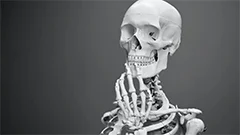Introduction
The temporal bone, one of the most complex bones in the human skull, is a unique and fascinating anatomical structure that plays a crucial role in both hearing and balance. This lesson aims to provide an in-depth exploration of this intricate bone, delving into its formation, structure, and functions within the context of osteology.
History of Temporal Bone Study
The temporal bone has been studied since antiquity, with early descriptions found in ancient Greek and Roman texts. However, it was not until the 16th century that a more comprehensive understanding began to emerge due to advancements in anatomical dissection techniques. Since then, our knowledge of this essential bone has grown exponentially, thanks to continued research and technological innovations.
Formation and Development
The temporal bone is formed by the fusion of several embryonic structures during fetal development. These structures include the otic capsule, the tympanohyal, the squamosal part, and the stylo-occipital part. The process of ossification occurs over a prolonged period, with different regions maturing at various times. Understanding this development is crucial for comprehending the mature anatomy of the temporal bone.
Structure of the Temporal Bone
Parts of the Temporal Bone
The temporal bone can be divided into three main parts: the petrous part, the squamosal part, and the mastoid part. Each part has a distinct shape, function, and set of associated structures.
The Petrous Part
The petrous part is the largest and densest section of the temporal bone, located deep within the skull. It houses several important components essential for hearing, including the cochlea, the semicircular canals, and the vestibule. Additionally, it provides attachment sites for various muscles involved in chewing and mastication.
The Squamosal Part
The squamosal part is situated at the base of the skull and forms part of the temporal line and zygomatic arch. It has a flattened, diamond-like shape and contains the styloid process, which serves as an attachment site for the stylopharyngeus muscle and the stylohyoid ligament.
The Mastoid Part
The mastoid part is situated posterior to the squamosal part and forms the mastoid process, a prominent ridge that can be felt on the side of the skull. This region is primarily involved in the attachment of muscles responsible for head movement.
Facets and Surfaces
Each part of the temporal bone features various facets and surfaces that serve as attachment sites for muscles, ligaments, and other structures. Understanding these connections is essential for comprehending the functional anatomy of the temporal bone.
Functions of the Temporal Bone
The temporal bone plays a crucial role in two critical functions: hearing and balance. The intricate network of structures within this bone allows it to transmit, amplify, and process sound waves while also maintaining our sense of balance through the vestibular system.
Hearing
The inner ear, which is housed within the petrous part of the temporal bone, contains the cochlea, semicircular canals, and vestibule. These structures work together to convert sound waves into electrical signals that are sent to the brain for interpretation. The temporal bone's unique shape and structure enable it to efficiently transmit and amplify these sound waves, ensuring efficient hearing.
Balance
The vestibular system, located within the inner ear, is responsible for maintaining balance and spatial orientation. The semicircular canals within the petrous part of the temporal bone detect movements of the head and send signals to the brain to adjust our position accordingly. This system plays a vital role in maintaining our stability during movement and preventing falls or other injuries.
Clinical Relevance
Understanding the anatomy and functions of the temporal bone is essential for various clinical applications, such as diagnosing and treating disorders related to hearing and balance. Additionally, knowledge of the temporal bone's complex structure can aid in the identification of fractures, tumors, or other abnormalities that may arise during imaging studies or surgical procedures.
Conclusion
The temporal bone is an intricate and fascinating structure that plays a crucial role in both hearing and balance. By exploring its formation, development, structure, and functions, we gain a deeper appreciation for this essential component of the human skeleton. This knowledge can not only enhance our understanding of human anatomy but also contribute to improved clinical practice in diagnosing and treating disorders related to hearing and balance.
MCQ: Test your knowledge!
Do you think you know everything about this course? Don't fall into the traps, train with MCQs! eBiologie has hundreds of questions to help you master this subject.
These courses might interest you
Create a free account to receive courses, MCQs, and advice to succeed in your studies!
eBiologie offers several eBooks containing MCQ series (5 booklets available free for each subscriber).




